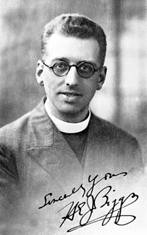By T. E. Crowley

The need for writing an obituary on an old and very highly regarded friend brings a realisation that little can be said which does not sound more conventional than sincere. It must at least be said that his place in the Society and in the affections of many of its members was unique, and will not again be filled; the time he so generously gave to helping other people and the enthusiasm which marked him will not be forgotten. The impression which remains is of his young, expressive, happy face beneath the ample white hair, the feeling that he had sampled the World, learned much about it, liked what he had found, and especially humanity. When he smiled, as he so often did, the impression became a certainty. He rarely spoke much of himself, his interest in other people was too great for that, and there cannot be many of his friends who knew the full story of his eventful and satisfying life.
Herbert Biggs was born at Edmonton, Middlesex on July 16th 1895 and received education at the Enfield Grammar School. He was early interested in natural history, and founded his own museum at the age of twelve, with a section for the mollusca of Enfield, which he collected himself in areas now completely built-up.
On leaving school, he took a job in the offices of the Great Eastern Railway, but on the outbreak of War, joined the 7th Battalion London Territorials on September 14th 1914, Went to France in March 1915 and was wounded at Festubert. He was commissioned 2nd Lieutenant in 1917 in the 10th (Duke of Wellington’s) West Riding Regiment, was drafted to Italy the same year, and promoted 1st Lieutenant 1918.
Upon demobiisation in the spring of 1919, he returned to employment in the G.E.R., where he worked in the drawing office until September 1922, when a more adventurous life attracted him, he sailed for Persia with the Church Missionary Society, and became headmaster of the Kerman Boys’ School for a period of two years. While there, he married Phyllis W. Cook in January 1924; she had travelled in the company of Persian muleteers across desert land from Bundar Abbas to Kerman for the ceremony, a remarkable journey for those days.
There followed a period of pastoral work for Bishop Linton in Isfahan from January 1925, but the autumn of 1928 found him back in England, studying at the London College of Divinity in preparation for his ordination, which took place the following year; he then returned to Persia as pastor of the Church at Kerman 1931–35.
A sojourn at Cairo then followed, where Biggs managed the business side of Arabic Christian Literature production, work which entailed travel in Palestine, Syria and the Sudan. In 1944, on his return to England, he became Rector of Mellis, Norfolk, and in 1948, Metropolitan Secretary for the United Society for Christian Literature until his retirement in 1960. This was retirement in name only, since he remained extremely busy in what he called "local work", involving the distribution of Christian literature and the taking of services in the district. In a letter received as recently as last December, he said "..... confined to bed at present, and I've had to let somebody down for a promised service. There are still plenty of uses for an odd parson": which illuminates his personality as well as any single remark could do.
He lost his wife in 1962, and late in 1963 he married Edith Constance Lewes of Aldeburgh, Suffolk, who he was wont to say, saved his life through most devoted nursing, when he was lying desperately ill in Cairo.
Shells remained Bert Biggs’ study and delight all his life; he joined the Conchological Society in 1919 and was President in 1958—6O. He was elected Fellow of the Linnean Society in 1956 and became an associate worker at the British Museum (Natural History) from 1960 to 1969. He also did much to lay the foundations of the European Malacological Union by becoming Secretary of the First European Malacological Congress in 1962. His death, which occurred on January 19th 1973, was due to a long-standing heart complaint.
By long study, Biggs had made himself an expert on the mollusca of the Near and Middle East, in particular those of the Persian Gulf, Red Sea, Eastern Mediterranean, and of the land areas round about them. He corresponded enthusiastically on the subject and was perpetually involved in discussions with, and identifications for, people all over the World. He also became very knowledgeable on archaeology. His capacity for hard work seemed almost inexhaustible, and the Society’s Junior Section stands a monument to his foresight; he originated the Section and ran it to the end. It tended to languish for a while but his faith in its success never wavered and he produced a succession of new ideas for publicity, education and interchange. He was rarely absent from ordinary meetings of the Society, where no one could fail to notice his almost boyish enthusiasm and his readiness to help. He was too, on occasion, a perfect chairman, both during his term of presidency and at various meetings afterwards; always audible, and directing the proceedings with tact, firmness and humour. On more than one occasion he was able to dispel an atmosphere of considerable acrimony in a way which it was an education to watch.
His personality and his talents will be badly missed indeed.
T. E. Crowley
